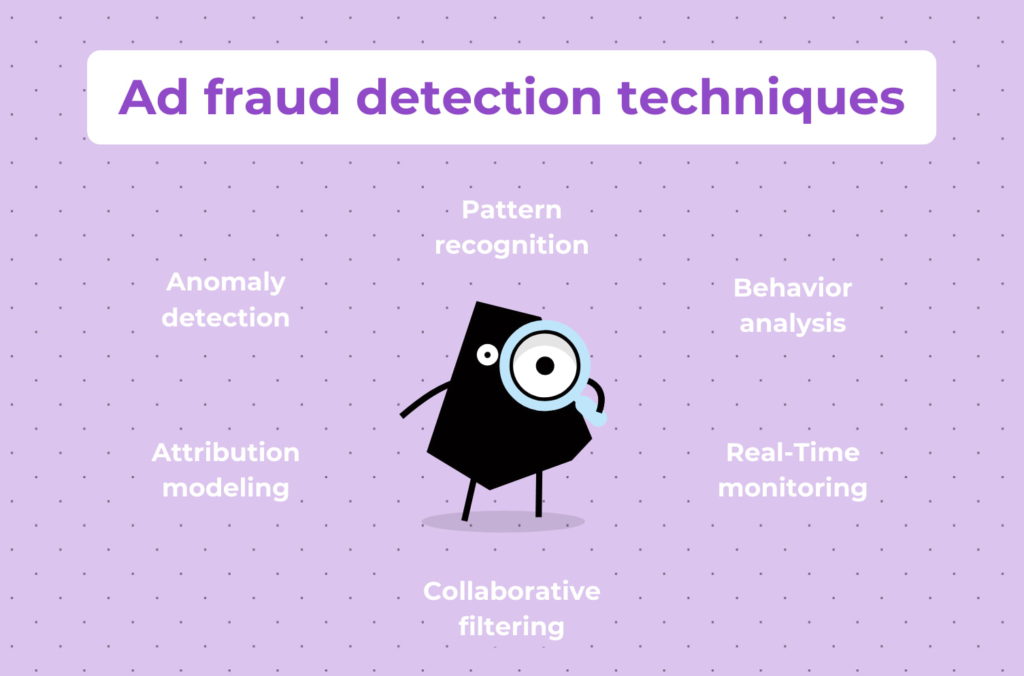10 ad fraud prevention tools and how to use them efficiently

In the world of online advertising, businesses face a significant challenge known as ad fraud, costing companies money and undermining trust. Ad fraud comes in many forms, from fake clicks to deceptive tactics that inflate advertising metrics. And understanding these fraudulent practices is crucial for businesses looking to protect their investments and maintain credibility in the digital marketplace.
In this article, we’ll delve into the intricacies of ad fraud, exploring its various types and how they impact businesses and the advertising industry as a whole. Then, we’ll introduce you to a range of tools and strategies designed to detect and prevent ad fraud. From advanced algorithms that analyze traffic patterns to comprehensive ad management platforms equipped with fraud prevention features, we’ll explore the arsenal of resources available to businesses seeking to safeguard their advertising investments.
Our mission is clear: to empower you with the knowledge and tools needed to navigate the complex landscape of digital advertising with confidence. So, welcome to X ad fraud prevention tools and how to use them efficiently. Allons-y!

What is ad fraud?
So, what is it – ad fraud? Simply put, ad fraud is when some individuals or groups of individuals try to trick online advertising systems. They do things like creating fake clicks on ads or making ads appear more times than they actually do. This tricks advertisers into paying for ads that aren’t really seen by people. Thus, ad fraud messes up advertising results and wastes money.
Common ad fraud techniques
Ad fraudsters employ various techniques to deceive advertisers and manipulate online advertising systems. And understanding these common tactics is essential for businesses to detect and prevent ad fraud effectively. So, here are common types of advertising frauds.
Click fraud. Click fraud involves the use of automated bots or scripts to generate fake clicks on online ads. These clicks appear to come from real users but are actually generated by bots, aiming to drain advertisers’ budgets and skew performance metrics.
Impression fraud. Impression fraud occurs when ads are served but not actually seen by real users. Fraudsters use techniques like hidden or stacked ads to artificially inflate impression counts, making advertisers believe their ads are reaching more people than they actually are.
Ad stacking. Ad stacking involves layering multiple ads on top of each other within a single ad placement. While only the top ad is visible to users, impressions and clicks are recorded for all stacked ads, leading to inflated metrics and wasted advertising spend.
Domain spoofing. Domain spoofing occurs when fraudsters misrepresent the website or app where an ad is displayed, making it appear as if the ad is shown on a premium site when it’s actually on a low-quality or fraudulent one. Advertisers end up paying premium prices for ad placements that don’t deliver the expected results.
Bot traffic. Bot traffic refers to automated software programs (bots) that mimic human behavior online. Fraudsters use bot traffic to inflate website traffic numbers and engagement metrics, leading advertisers to believe their ads are reaching real users when they’re not.
Cookie stuffing. Cookie stuffing involves placing unauthorized tracking cookies on users’ devices without their knowledge or consent. This technique allows fraudsters to take credit for conversions and sales that they didn’t actually influence, leading to inaccurate attribution and wasted advertising budgets.
Ad injection. Ad injection involves the unauthorized placement of ads on websites or apps without the knowledge or consent of the site owners or advertisers. This often happens through browser extensions or malware that injects additional ads into webpages, leading to user experience issues and ad fraud.
Detecting ad fraud
In our exploration of ad fraud prevention, the next frontier lies in detecting fraudulent activities. Ad fraud detection is pivotal in ensuring the effectiveness and integrity of digital advertising campaigns. As businesses navigate through the complexities of the digital landscape, the ability to identify and mitigate ad fraud becomes increasingly crucial.
This section delves into the strategies and technologies employed by businesses to detect ad fraud effectively. From sophisticated algorithms to real-time analytics, the tools and methodologies used for fraud detection continue to evolve, driven by the relentless pursuit of transparency and accountability in digital advertising.
Ad fraud detection techniques
The ad fraud detection techniques, ranging from sophisticated algorithms to dynamic surveillance systems, function both independently and collaboratively. Alone, they uncover suspicious anomalies indicative of ad fraud. Together, they form a formidable defense, synergizing efforts to protect advertising investments effectively. By comprehensively understanding and utilizing these techniques, businesses can better safeguard their advertising endeavors, ensuring integrity and trust within the digital advertising landscape.

Anomaly detection. Anomaly detection techniques analyze patterns and deviations from normal behavior to identify potentially fraudulent activities. By establishing baseline performance metrics and monitoring deviations in ad engagement and traffic patterns, anomaly detection algorithms can flag suspicious activities for further investigation.
Behavior analysis. Behavior analysis involves monitoring user interactions and engagement patterns to detect abnormal behavior indicative of ad fraud. By analyzing user engagement metrics such as click-through rates, time spent on site, and conversion rates, businesses can identify anomalies and patterns consistent with fraudulent activities.
Pattern recognition. Pattern recognition algorithms leverage machine learning and data analytics to identify recurring patterns and trends associated with ad fraud. By analyzing historical data and identifying common characteristics of fraudulent traffic or engagement, pattern recognition techniques can help businesses proactively detect and prevent ad fraud.
Attribution modeling. Attribution modeling enables businesses to attribute conversions and sales to specific ad campaigns or channels accurately. By tracking user interactions across multiple touchpoints and attributing conversions to the most influential ad exposures, attribution modeling helps businesses identify fraudulent attribution patterns and discrepancies in conversion data.
Real-Time monitoring. Real-time monitoring platforms enable businesses to monitor ad campaigns and traffic patterns in real time, allowing for immediate detection and response to fraudulent activities. By leveraging real-time analytics and alerts, businesses can identify anomalies and take corrective action to mitigate the impact of ad fraud on their advertising campaigns.
Collaborative filtering. Collaborative filtering techniques analyze user behavior and engagement data to identify similarities and anomalies across user profiles and interactions. By identifying patterns of fraudulent behavior and sharing insights across ad networks and platforms, collaborative filtering enables businesses to detect and prevent ad fraud more effectively.
Tools for ad fraud prevention, detection, and protection
Fortunatelly for businesses, while some people create ad frauds, others created tools for ad fraud detection, ad fraud prevention and ad fraud protection. And fortunately for you, today we will talk about them all.
Want to develop custom
AdTech software?
FraudScore. FraudScore offers real-time monitoring and fraud prevention solutions to protect digital advertising campaigns from fraudulent activities. It provides comprehensive analytics and detection capabilities to identify and block suspicious traffic sources.
HUMAN. HUMAN specializes in bot detection and prevention services, leveraging machine learning algorithms to identify and mitigate ad fraud. Its solutions help businesses protect their advertising investments by detecting and blocking bot traffic.
GeoEdge. GeoEdge provides ad security solutions to protect publishers and advertisers from malicious and non-compliant ads. Its tools offer real-time monitoring, ad quality verification, and malware detection to prevent ad fraud.
IAS (Integral Ad Science). IAS offers ad verification and fraud detection solutions to advertisers and publishers. Its proprietary technology analyzes ad impressions, clicks, and conversions to detect and prevent ad fraud in real time.
Adloox. Adloox offers ad verification and brand safety solutions with built-in fraud detection capabilities. Its tools use advanced algorithms to monitor ad traffic and detect fraudulent activity across digital advertising channels.
Anura. Anura provides ad fraud protection solutions with real-time detection and prevention capabilities. Its tools analyze user behavior and traffic patterns to identify and block fraudulent activity across digital advertising campaigns.
Protected Media. Protected Media offers ad fraud protection solutions for advertisers and publishers. Its tools use advanced algorithms to detect and block invalid traffic, bot activity, and other forms of ad fraud in real time.
DoubleVerify. DoubleVerify offers ad verification and fraud protection solutions to advertisers, publishers, and ad networks. Its tools provide comprehensive monitoring and protection against ad fraud, ensuring the integrity of digital advertising campaigns.
Cheq. Cheq specializes in ad verification and fraud prevention solutions for digital advertisers. Its tools use machine learning and predictive analytics to identify and mitigate ad fraud risks across online advertising channels.
Custom AdTech solution
For companies operating within the AdTech industry, the prospect of crafting a custom ad fraud solution holds significant promise. By amalgamating insights from various ad fraud prevention tools such as FraudScore and White Ops, fortified with robust detection solutions like Pixalate and Forensiq, and complemented by protective measures such as Anura and DoubleVerify, adtech firms can develop tailored defenses against ad fraud. These custom solutions enable companies to adapt swiftly to evolving threats and address specific challenges within their advertising ecosystems. By synergizing the strengths of diverse tools and technologies, adtech firms can bolster their capabilities to detect, prevent, and mitigate ad fraud effectively, safeguarding the integrity and efficiency of their digital advertising endeavors.
How to get a custom AdTech solution?

The demand for tailored solutions to combat ad fraud is paramount. As businesses seek to fortify their defenses against fraudulent activities, the option of developing custom AdTech solutions emerges as a strategic imperative. By amalgamating insights from various ad fraud prevention, detection, and protection tools, companies can create bespoke defenses that align closely with their unique needs and objectives.
Our team of experts is dedicated to understanding your requirements and leveraging cutting-edge technologies to develop a solution for your challenge, whether it’s ad frauds or something else.
GreenM is here ready to guide you every step of the way, so, don’t hesitate to contact us.
See you soon!






